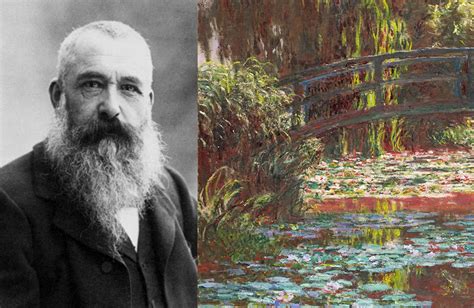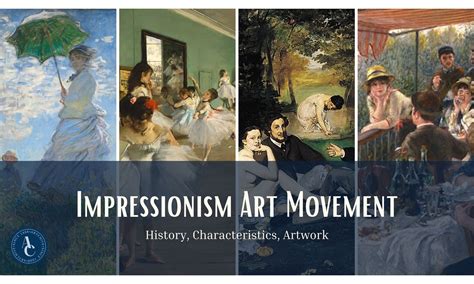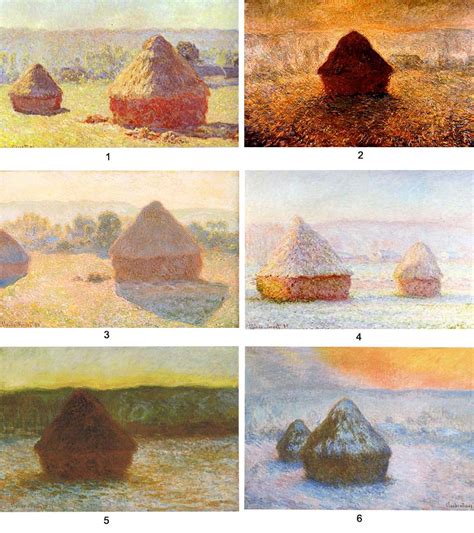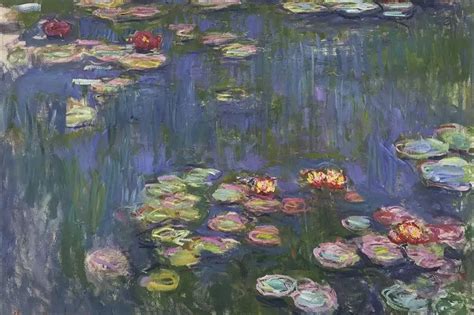Immerse yourself in the captivating world of one of art's most influential figures, a mastermind whose brushstrokes revolutionized the way we perceive and interpret the world. Step into the realm of a visionary artist whose pioneering style transcended traditional boundaries, capturing the essence of fleeting moments in vivid hues.
Delve into the extraordinary life of a creative genius who broke free from the shackles of conventional art, paving the way for a movement that would forever change the course of artistic expression. With each stroke of his brush, this remarkable individual defied artistic norms, daring to blend colors and evoke emotions like never before.
Prepare to be spellbound as we embark on an enthralling journey through the life and works of a true pioneer of impressionist art. Discover how this extraordinary talent honed his craft, transforming the canvas into a reflection of his unique perspective. Through his sheer passion and unwavering dedication, he redefined the boundaries of art, leaving an indelible mark on the world of beauty and creativity.
With each composition, this master of the brush unveiled a new dimension, a distinct perspective that challenged the limits of reality. His art breathed life into landscapes, infused nature with vibrancy, and revealed the ephemeral beauty that surrounds us. Through a lifetime of artistic exploration, he unveiled the world as seen through his own, resolutely original lens.
Claude Monet: A Visionary Artist Ahead of His Time

In the realm of art, there are rare individuals who possess an extraordinary ability to transcend the boundaries of their time and create something truly groundbreaking. Claude Monet, a visionary artist from the late 19th to early 20th century, was one such luminary. His innovative approach to painting and profound understanding of light, color, and nature revolutionized the art world and laid the foundation for the Impressionist movement.
Monet's artistic vision can be best described as a profound connection between the external world and his inner emotions. Through his brushstrokes, he transported viewers into the heart of his unique perspective, inviting them to experience the world as he saw it. His paintings were not merely accurate representations of the physical world but acts of pure artistic expression, filled with vibrant colors, fluid shapes, and a sense of fleeting beauty.
One of Monet's most distinctive qualities was his ability to capture the essence of a scene in a single moment. His paintings were like snapshots frozen in time, capturing the ever-changing nature of light, weather, and atmosphere. Whether it was the ethereal mist over a tranquil pond or the dazzling play of sunlight on a field of flowers, Monet had an unparalleled talent for capturing the ephemeral qualities of his subjects.
Furthermore, Monet's avant-garde use of color challenged the traditional notion of how colors should be applied in painting. He abandoned the use of dark, muted tones prevalent in the art of his time and instead embraced a vibrant palette that reflected the true intensity of natural light. By doing so, he conveyed a sense of vitality and energy that was unprecedented in the art world.
Despite facing criticism and rejection early in his career, Monet remained steadfast in his artistic vision and continued to push the boundaries of his craft. His dedication to his craft and unwavering pursuit of his artistic vision ultimately established him as a pioneer of the Impressionist movement and secured his place in the pantheon of art history.
Early Life and Artistic Influences
Exploring the formative years and the diverse sources of inspiration that shaped Claude Monet's artistic journey.
In his formative years, Claude Monet embarked on a creative path that would revolutionize the art world. Born in 1840, this visionary artist was influenced by a multitude of factors that played a significant role in shaping his unique artistic style. Monet's upbringing in Le Havre, France, fostered his early fascination with the natural world. The picturesque coastal town provided him with a constant source of inspiration, igniting in him a love for capturing the interplay of light and color. From a young age, Monet found solace in observing the ever-changing scenes of the sea and the sky. As Monet's artistic ambitions grew, he sought formal training and guidance to refine his skills. He studied under the tutelage of Charles Gleyre in Paris, where he befriended other influential artists such as Pierre-Auguste Renoir and Édouard Manet. This creative community sparked a spirit of innovation and experimentation that would define the Impressionist movement. |
The Emergence of the Impressionist Movement

During the second half of the 19th century, a group of innovative artists in France spearheaded a revolutionary artistic movement, forever changing the course of art history. This movement, commonly known as Impressionism, emerged as a radical departure from the traditional art conventions prevalent at the time. It challenged the established norms of representation and embraced a unique approach that prioritized capturing the fleeting essence of a moment rather than precise details. This section explores the factors that led to the formation of the Impressionist movement and the key characteristics that defined this groundbreaking artistic style.
- The Rise of plein air painting:
- Breaking away from academic constraints:
- Exploration of light and color:
- Alternative exhibition methods:
- Impact on later artistic developments:
One of the key catalysts that contributed to the emergence of Impressionism was the growing practice of plein air painting. Artists began venturing outdoors, leaving behind their studios, in order to capture the natural light and atmosphere of their surroundings. This shift in focus from academic studios to open-air environments allowed for a more direct and spontaneous response to the ever-changing appearance of nature.
Impressionist artists sought to break away from the rigid rules and constraints imposed by the French Academy of Fine Arts. They sought to challenge the notion that art had to faithfully represent reality and instead embraced a more subjective and personal interpretation of the world around them. By rejecting the traditional emphasis on finish and meticulous detail, they aimed to capture the immediate sensory impressions and emotions evoked by their subjects.
Impressionists were intrigued by the effects of light and color on their subjects. They forsook the use of muted tones and the practice of mixing colors on a palette. Instead, they applied vibrant and pure hues directly onto the canvas, aiming to convey the transient nature of light and its impact on the visual experience. This emphasis on the play of light and color resulted in the creation of vibrant, luminous, and dynamic compositions.
The Impressionists faced consistent rejection from the conservative art establishment, which led them to seek alternative ways to exhibit their works. In 1874, Claude Monet and his fellow artists organized their own exhibition, known as the first Impressionist Exhibition. This event provided a platform for these avant-garde painters to showcase their artworks and establish themselves as a cohesive artistic movement.
As history unfolded, the Impressionist movement had a profound influence on subsequent artistic movements, such as Post-Impressionism, Symbolism, and Fauvism. Their bold rejection of artistic conventions and their pursuit of capturing the fleeting beauty of the world around them left an indelible mark on the trajectory of modern art.
Monet's Innovative Painting Techniques
In the realm of art, Claude Monet made a significant impact as a revolutionary artist who challenged traditional painting techniques and introduced progressive methods that forever changed the art world. His pioneering approach encompassed unique brushwork, vibrant colors, and a focus on capturing the fleeting moments of nature. Through his exceptional talent and unwavering dedication, Monet paved the way for future generations of artists to explore and experiment with new artistic possibilities.
One of the distinguishing features of Monet's painting techniques was his emphasis on capturing the transience of light and its effects on the surrounding environment. He meticulously observed the changing atmospheric conditions, carefully studying the interplay between light and shadow, and translated these observations onto his canvas. By employing short, quick brushstrokes and layering multiple thin coats of paint, Monet was able to create an optical blend of colors that brilliantly conveyed the fleeting nature of light.
Another aspect that set Monet apart was his use of vibrant and unconventional colors. Unlike the traditional palette dominated by muted tones, he daringly introduced vivid hues such as vibrant blues, purples, and bright greens into his landscapes and seascapes. By using these bold colors, Monet aimed to capture the essence of a scene, infusing his paintings with a sense of energy and vitality that brought his subjects to life.
Furthermore, Monet's unique ability to capture the essence of a scene in its natural state revolutionized the concept of plein air painting. He preferred to work outdoors directly in front of his subjects, whether it be a meadow of flowers, a serene pond, or a bustling city street. This approach allowed him to immerse himself in the environment, capturing the ever-changing nuances of light and atmosphere. By doing so, Monet was able to convey a sense of immediacy and spontaneity in his paintings, as if they were glimpses frozen in time.
Monet's revolutionary painting techniques not only challenged artistic conventions but also sparked a new movement known as Impressionism. Through his daring brushwork, vibrant colors, and dedication to capturing fleeting moments, he inspired a generation of artists to break free from tradition and explore new horizons. Monet's impact on the art world continues to resonate today, as his innovative techniques remain timeless and influential.
- Revolutionary brushwork
- Vibrant and unconventional colors
- Focus on capturing transience of light
- Plein air painting and capturing natural essence
- Inspiring the Impressionist movement
Exploring Light and Color in Monet's Artistic Vision

Delving into the masterworks of Claude Monet reveals an enchanting exploration of light and color, as the artist captured the essence of the ever-changing natural world. Monet's revolutionary approach to depicting the interplay of light and its effect on colors transformed the artistic landscape of his time and continues to inspire generations of artists to this day.
Through his paintings, Monet transcended the boundaries of traditional art, conveying the fleeting and ephemeral nature of light. His brushstrokes, characterized by their loose and spontaneous technique, imbued his works with a sense of energy and movement. With a masterful use of color, Monet skillfully depicted the subtle shifts in light, capturing its nuances and its transformative impact on the surrounding environment.
Monet's keen observation of the natural world enabled him to create immersive landscapes that seemingly transported viewers to the scenes he painted. His ability to harness the vibrant colors of nature, from the vibrant blues of a sunlit sky to the delicate pastels of a blooming garden, allowed him to create works that evoke visceral emotional responses.
Throughout his career, Monet experimented with different lighting conditions, exploring the effects of various times of day and weather conditions on his subjects. From the hazy mist of sunrise to the vibrant hues of sunset, his paintings showcase the dynamic interplay of light and color, capturing the essence of each moment in time.
By employing techniques such as broken brushwork and a subtle layering of complementary colors, Monet achieved a sense of depth and texture in his paintings. His mastery of capturing the ever-changing qualities of light allowed him to recreate its ethereal beauty on the canvas, giving his works a sense of life and vitality.
In conclusion, Monet's artistic vision pushed the boundaries of traditional art by exploring the transformative power of light and color. Through his innovative techniques and acute observation of the natural world, he created a body of work that continues to captivate and inspire audiences, leaving an indelible mark on the history of art.
Monet's Passion for Landscapes and the Beauty of Nature
One of the defining aspects of Claude Monet's artistic career was his deep love for landscapes and his relentless pursuit to capture the beauty of nature on canvas. Throughout his life, Monet found solace, inspiration, and boundless creativity in the natural world, often venturing out into the countryside to immerse himself in its enchanting scenery.
Nature became Monet's muse, his source of inspiration, and his sanctuary. He believed that there was an inherent and profound connection between art and the natural world, which he dedicated his life to exploring and expressing through his masterful brushstrokes. By devoting his artistic vision to the landscapes that surrounded him, Monet sought to convey not only the visual beauty of nature but also the emotional and sensory experience it evoked within him.
Monet's artistry was deeply rooted in his ability to capture the fleeting moments of natural light and the ever-changing atmosphere. Through his unique style, characterized by loose brushwork, vibrant colors, and an emphasis on capturing the essence of a scene rather than its precise details, Monet created landscapes that appeared alive and dynamic.
With each stroke of his brush, Monet skillfully portrayed the play of light and shadow, the movement of leaves and water, and the myriad of colors that danced across the natural landscape. His paintings exude a sense of tranquility, inviting viewers to explore and connect with the beauty of nature.
Monet's love for landscapes went beyond mere aesthetic appreciation; it was a profound admiration for the harmony and serenity that nature bestowed. He believed that by immersing oneself in nature, one could find solace, inner peace, and a healing connection with the world. Through his art, Monet aspired to convey this profound connection to his viewers, inviting them to experience the splendor of nature and embrace its mesmerizing allure.
The Iconic Water Lily Paintings
Exploring Claude Monet's renowned works of art portraying the beauty and serenity of water lilies.
The Majestic Serenity:
One of Claude Monet's most notable contributions to the world of art lies in his iconic water lily paintings. These magnificent artworks showcase Monet's exceptional ability to capture the essence of nature and evoke a sense of tranquility and calmness. With his brush strokes, colors, and compositions, Monet created masterpieces that transport viewers to peaceful water gardens filled with floating lilies.
A Harmony of Colors:
In his water lily paintings, Monet skillfully employed a harmonious palette of vibrant and soft hues, offering a visual symphony for the eyes. The interplay of colors, ranging from delicate pinks and purples to vivid blues and greens, creates a sense of depth and movement within the serene scenes. The reflections of the lilies and surrounding foliage in the gently rippling water add an ethereal touch, making these artworks truly mesmerizing.
An Impression of Nature:
Monet's water lily paintings exemplify the impressionistic style, where the focus is on capturing the fleeting impressions of a scene rather than rendering detailed realism. By utilizing bold brushwork and loose strokes, Monet conveyed the ever-changing atmosphere and the play of light on the water's surface. These impressionistic techniques give these paintings a sense of spontaneity, immersing the viewer in the artist's personal experience and emotional connection with the subject.
Influence and Legacy:
The water lily paintings by Claude Monet continue to inspire and captivate audiences worldwide. These artworks have left an indelible mark on the art world, influencing generations of artists to experiment with color, technique, and interpretation. Monet's innovative approach to capturing the beauty of nature and his unique portrayal of water lilies have solidified his position as one of the most influential artists in history.
Immerse yourself in the timeless beauty of Monet's water lily paintings and experience the serenity that these remarkable artworks convey.
Monet's Enchantment with Japanese Culture
Throughout his illustrious career, the renowned French artist Claude Monet displayed an unquenchable fascination for the captivating allure of Japanese culture. A profound admiration for the artistic traditions, philosophy, and motifs of the Far East permeated Monet's works, leaving an indelible mark on the development of his distinctive artistic style. Expanding beyond the realms of Western art, Monet's exploration of Japanese aesthetics and techniques propelled him towards creating innovative and visionary masterpieces that redefined the boundaries of Impressionism.
Emerging during a period when Japan was gradually opening up to the Western world, Monet seized the opportunity to immerse himself in this novel cultural exchange. He found inspiration in the ukiyo-e woodblock prints, which depicted everyday scenes from Japanese life, landscapes, and subjects infused with vibrant colors and textures. The subtleties of composition, delicate use of light and shadow, and the emphasis on capturing transience across different seasons deeply resonated with Monet's artistic sensibilities.
Motivated by a desire to infuse his own art with the spirit of Japanese aesthetics, Monet diligently studied various Japanese art forms, including calligraphy and Ikebana (flower arrangement). He sought to incorporate their principles of harmony, simplicity, and asymmetry into his paintings, seeking to create a harmonious balance between nature and man-made elements. Monet's exploration of Japanese culture enabled him to transcend the conventions of traditional Western art, boldy experimenting with new brushwork techniques, employing an expanded color palette, and capturing fleeting moments like the cherry blossoms.
Monet's immersion in Japanese culture not only affected his artistic visions but also impacted his personal life. The influence of Japanese gardens can be seen in the careful designs of his own Giverny garden, with its water lilies and the iconic Japanese bridge. Moreover, the power of Japanese symbolism can be observed in the recurring motifs of Japanese bridges, parasols, and kimonos present in his later paintings.
In conclusion, Monet's captivation with Japanese culture was a driving force behind his artistic evolution and left an indelible imprint on the world of art. His tireless exploration and incorporation of Japanese aesthetics, techniques, and motifs pushed the boundaries of Impressionism, shaping his unique artistic vision and leaving a lasting legacy for future generations to admire and appreciate.
Monet's Path to Recognition and Triumph

As an eminent figure in the realm of art, Claude Monet faced numerous challenges throughout his career in garnering recognition and achieving success. Endeavoring to establish an artistic style that depicted fleeting impressions of natural landscapes, Monet encountered initial resistance and skepticism from conventional art institutions and critics. Nonetheless, his relentless dedication to capturing the essence of light and atmosphere ultimately led to widespread recognition and acclaim.
Monet's journey towards recognition was accompanied by unfavorable circumstances and financial hardships. Struggling to make ends meet, he faced rejection from art exhibitions and experienced prolonged periods of financial insecurity. However, Monet's unwavering commitment to his artistic vision and relentless determination propelled him forward.
In the face of adversity, Monet found solace and inspiration in the company of fellow artists who shared a similar passion for challenging traditional art conventions. Together, they formed the groundbreaking Impressionist movement, which aimed to portray the transient beauty of nature through the innovative use of light, color, and brushstrokes.
Monet's breakthrough came with his renowned series of paintings portraying different perspectives of the same subject, such as his famous Water Lilies and Haystacks series. These works demonstrated his mastery in capturing the ever-changing effects of light and atmosphere, elevating him to the status of an artistic pioneer.
- Despite initial criticism and rejection, Monet's unwavering dedication to his craft finally gained him recognition and success.
- Financial hardships and rejection from traditional art institutions only fueled Monet's determination to establish himself as an innovative artist.
- Through the formation of the Impressionist movement, Monet found support and collaboration from like-minded artists, propelling the movement to prominence.
- The distinct series of paintings, such as the Water Lilies and Haystacks, solidified Monet's reputation as a pioneer in capturing the fleeting aspects of nature.
- Monet's struggle for recognition and triumph serves as a testament to his unwavering dedication and pioneering spirit, leaving behind a profound artistic legacy.
Lasting Legacy and Influence on Modern Art
Throughout the artistic realm, Claude Monet left an indelible mark that still resonates in contemporary times. His groundbreaking approach to capturing fleeting moments and impressions on canvas paved the way for the evolution of modern art. Monet's inventive use of light and color, along with his dedication to depicting natural landscapes and everyday scenes, influenced countless artists and transformed the course of artistic expression.
One of Monet's most significant contributions was his departure from the traditional academic style of painting. Instead of meticulously portraying every detail, he focused on conveying the essence and atmosphere of a scene through bold brushstrokes and vibrant colors. This innovative technique, known as Impressionism, challenged the established norms of the art world and revolutionized the way artists approached their craft.
Monet's ability to capture the fleeting qualities of light and atmosphere had a profound impact on future artists. His exploration of the changing qualities of light and the effects it had on colors and forms served as a catalyst for the development of new artistic movements. From the Post-Impressionists to the Fauvists and beyond, Monet's influence can be traced through the various art movements that emerged in the 20th century.
Furthermore, Monet's dedication to depicting nature in its purest form inspired generations of landscape artists. His immersive and detailed portrayals of gardens, water lilies, and rural scenes continue to captivate audiences today. The emphasis he placed on the natural world and his ability to capture its essence embody the essence of modern ecological and environmental art movements.
Monet's impact goes beyond his artistic techniques and subject matter; he also played a vital role in the development of art institutions. By establishing the Société Anonyme des Artistes, Peintres, Sculpteurs, Graveurs, Monet sought to provide artists with the opportunity to exhibit their works outside the confines of the traditional salon. This groundbreaking move challenged established art institutions and helped pave the way for the democratization of art.
In conclusion, Claude Monet's lasting legacy and influence on modern art can be seen in his innovative techniques, his dedication to depicting nature, and his role in challenging established art institutions. His impact reverberates through the diverse artistic movements of the 20th century and continues to inspire and captivate present-day artists and art enthusiasts alike.
Exploring Monet's Artworks Across the Globe

Traveling the world, one can discover the vast collection of exquisite paintings created by the renowned artist Claude Monet. These extraordinary masterpieces captivate viewers with their unique beauty and artistic vision. From breathtaking landscapes to serene water lilies, Monet's paintings showcase his innovative approach to capturing the essence of nature and light.
Visiting various museums and galleries, art enthusiasts have the opportunity to delve into Monet's artistic journey as they explore the diverse range of his creations. Whether it be the vibrant colors of his Rouen Cathedral series or the serene tranquility of his Japanese Bridge paintings, each artwork offers a glimpse into Monet's creative evolution.
Embracing the Impressionist style, Monet's artworks have left an indelible mark on the art world, inspiring generations of artists and art lovers. With his brushstrokes and keen eye for detail, Monet revolutionized the way artists depicted the world around them, breaking free from traditional artistic conventions.
- Admire the ethereal beauty of Monet's Water Lilies at Musée de l'Orangerie in Paris, France.
- Immerse yourself in the enchanting landscapes of Giverny, France, where Monet resided and painted his famous garden scenes.
- Marvel at his iconic haystacks and grainstacks series at the Art Institute of Chicago, USA.
- Experience the vibrant colors and exquisite details of Monet's Venice paintings at the Gallerie dell'Accademia in Venice, Italy.
- Witness the enchanting play of light and shadows on Monet's Rouen Cathedral series at the Musée des Beaux-Arts de Rouen, France.
- Discover Monet's fascination with the effects of winter through his collection of snowscape paintings at the National Gallery in London, UK.
Monet's art transcends time and borders, allowing art enthusiasts from across the globe to appreciate his unparalleled talent and creativity. By exploring Monet's paintings around the world, one can truly grasp the magnitude of his artistic contributions and the lasting legacy he has left behind.
FAQ
Who is Claude Monet?
Claude Monet was a French painter and one of the founders of the Impressionist movement in the late 19th century. He is widely regarded as one of the greatest painters in the history of art.
What were Claude Monet's major achievements?
Claude Monet's major achievements include his innovative approach to painting, his role in the development of Impressionism, and his series of paintings depicting the same subject at different times of day. He also successfully captured the essence of nature and light in his works.
Why is Claude Monet considered a pioneer of Impressionist art?
Claude Monet is considered a pioneer of Impressionist art because he was one of the first painters to deviate from the traditional techniques and subject matter of the time. He focused on capturing the ever-changing effects of light and color in the natural world, often painting en plein air.
What influenced Claude Monet's artistic style?
Claude Monet's artistic style was influenced by the works of earlier painters, such as Eugene Boudin and Johan Barthold Jongkind, who introduced him to en plein air painting. He was also inspired by Japanese art and the concept of capturing fleeting moments of time.
What is Claude Monet's legacy in the art world?
Claude Monet's legacy in the art world is immense. His innovative techniques and bold use of color paved the way for modern art movements. He continues to be celebrated as one of the most influential artists in history, and his works are displayed in museums and galleries worldwide. His contributions to Impressionism are widely recognized and admired.
Who was Claude Monet?
Claude Monet was a renowned French artist who is considered one of the pioneers of Impressionism. He was born on November 14, 1840, in Paris, and is best known for his landscapes and outdoor scenes.
What is Impressionism?
Impressionism was an art movement that emerged in the late 19th century in France. It is characterized by its focus on capturing fleeting moments and the effects of light and color on the subject. Instead of precise details, Impressionist artists used loose brushwork and vibrant colors to create their works.



